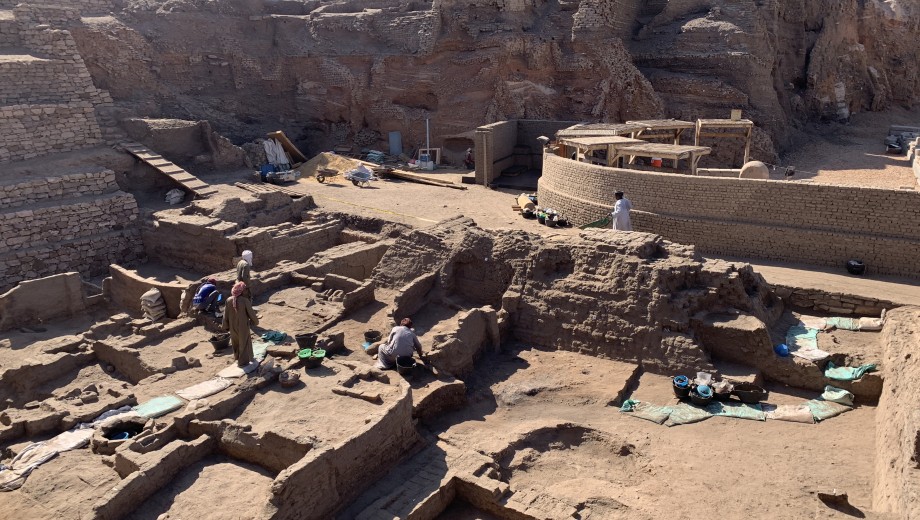Every year, Nadine Moeller, associate professor of Egyptian archaeology, and OI research associate Gregory Marouard bring UChicago graduate students to join their dig at Tell Edfu, on the west bank of the Nile in southern Egypt.
The excavation, led by the Oriental Institute, is an important educational site, offering students first-hand experience with settlement archaeology: studying ancient cities and towns to unearth clues about how Egyptians of that era lived day to day.
The 2018 excavation season (September–December) focused on a large urban villa dating back to the early New Kingdom (about 1500 to 1450 BCE) and revealed a domestic sanctuary with a shrine dedicated to ancestor worship—the first discovery of its kind in over 80 years.
Egyptian Archaeology graduate students Émilie Sarrazin, AM’15; Sasha Rohret, AM’15; and Raghda (Didi) El-Behaedi go deeper into their excavation experiences.
How did you get interested in Ancient Egypt?
El-Behaedi: I’m originally from Egypt but left when I was only two years old, so to me, studying Ancient Egypt was a natural development in wanting to reconnect with my roots. I think Ancient Egypt is still such a large component of the everyday, modern Egyptian culture that it isn’t very hard to become completely spellbound by this enthralling civilization.
Rohret: Like for many kids, National Geographic hooked me on archaeology when I was young, but it wasn’t until the summer between sophomore and junior year of college [at Harvard], when I went on my first excavation in Cyprus, that I really fell in love with the subject. The following semester, Harvard hired Peter Der Manuelian, PhD’90, its first Egyptologist since George Reisner [who held an appointment from 1905 to 1942], and his classes were so interesting and engaging that I decided to focus on ancient Egypt.
How do you know if you’ve found something notable?
Sarrazin: Anything unusual is “notable,” so it depends on what is “usual” at your archaeological site. In an ancient settlement, we usually excavate mudbrick houses and courtyards that have been slowly abandoned by their inhabitants. What we recover are the objects they left behind: broken pottery, animal bones, and other small finds like beads or stone tools. We rarely recover artifacts that were finely made or made using precious material—these types of objects usually weren’t left behind—and objects are rarely found in their original context of use; they are usually found where they were thrown away. So finding the ancestor shrine with its finely crafted objects in place was exceptional.
Rohret: Like much of settlement archaeology, where we don’t tend to get the most extravagant or flashy finds, what is notable in studies involving animal bones doesn’t usually show up until the analysis phase, when I have a chance to compile all the data and find interesting trends. Occasionally, though, I’ll stumble on something in the field that gets me really excited, like the juvenile hippopotamus bones we’ve found at Edfu over the last few years. This was an exciting find because hippo bones are not common in settlement sites, and the ones we found showed evidence of burning and butchery. Since eating hippos is not something that is attested in ancient texts or imagery, I knew this would be something fascinating to look into more as work progresses.
Who found the domestic shrine statues and stela unearthed at Tell Edfu in 2018?
Sarrazin: Although there’s always a little thrill being the one to find important artifacts, archaeology is about teamwork and, in the end, it doesn’t matter who found them. Sometimes the person who finds an artifact is not who will excavate, photograph, or record it. For instance, the tip of the seated statue was noticed by one of our local specialists, [Raïs] Yasser [Mohamed Hassan]; I excavated it and noticed it was a statue; our ceramicist Aaron [de Souza] photographed it; and Rebecca [Wang] did preliminary work on the inscription.
The inscribed stela with the carved couple was found face down in the area that Yasser, Ahmed [Ghalib Mohamed], and I were excavating, but Didi and Rebecca were the ones who turned it around and noticed the inscription. What’s important is that everybody works together to properly record as much data about the artifacts and their context as possible, particularly when it comes to important finds such as these, because time is of the essence—such objects are quickly sent to storage magazines with proper security, so we have to act fast.
What was your favorite moment in the field?
Rohret: I was pretty excited when I identified the baby hippo bones a couple of years ago, but my favorite times have been sharing the little moments with others in the field, like digging in the “never-ending room” with Émilie during our first season at Edfu together and helping to reassemble pottery sherd fragments with Katarina Arias [from Charles University in Prague]. That said, it never hurts when we stumble upon amazing finds like the domestic shrine.

